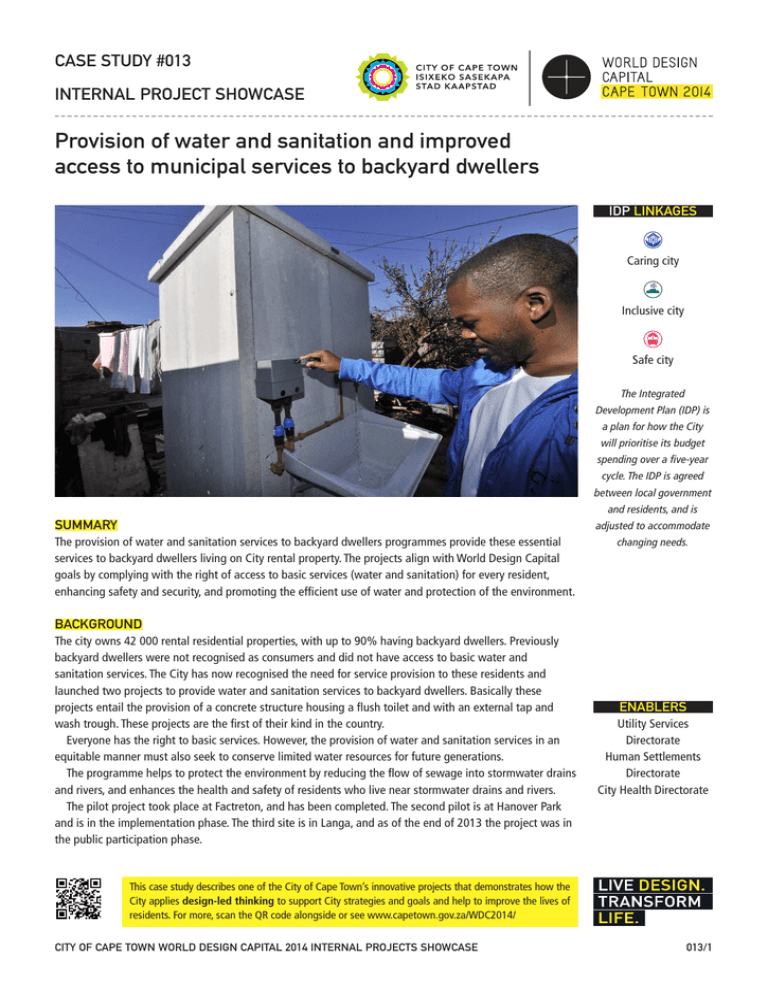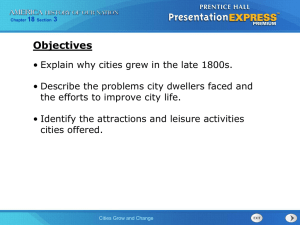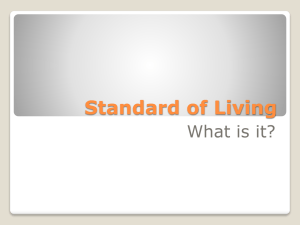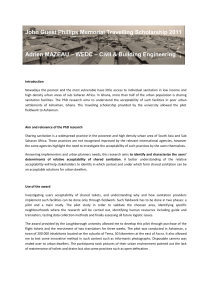Provision of water and sanitation and improved CASE STUDY #013
advertisement

CASE STUDY #013 INTERNAL PROJECT SHOWCASE Provision of water and sanitation and improved access to municipal services to backyard dwellers IDP LINKAGES Caring city Inclusive city Safe city The Integrated Development Plan (IDP) is a plan for how the City will prioritise its budget spending over a five-year cycle. The IDP is agreed between local government and residents, and is SUMMARY adjusted to accommodate The provision of water and sanitation services to backyard dwellers programmes provide these essential services to backyard dwellers living on City rental property. The projects align with World Design Capital goals by complying with the right of access to basic services (water and sanitation) for every resident, enhancing safety and security, and promoting the efficient use of water and protection of the environment. changing needs. BACKGROUND The city owns 42 000 rental residential properties, with up to 90% having backyard dwellers. Previously backyard dwellers were not recognised as consumers and did not have access to basic water and sanitation services. The City has now recognised the need for service provision to these residents and launched two projects to provide water and sanitation services to backyard dwellers. Basically these projects entail the provision of a concrete structure housing a flush toilet and with an external tap and wash trough. These projects are the first of their kind in the country. Everyone has the right to basic services. However, the provision of water and sanitation services in an equitable manner must also seek to conserve limited water resources for future generations. The programme helps to protect the environment by reducing the flow of sewage into stormwater drains and rivers, and enhances the health and safety of residents who live near stormwater drains and rivers. The pilot project took place at Factreton, and has been completed. The second pilot is at Hanover Park and is in the implementation phase. The third site is in Langa, and as of the end of 2013 the project was in the public participation phase. ENABLERS Utility Services Directorate Human Settlements Directorate City Health Directorate This case study describes one of the City of Cape Town’s innovative projects that demonstrates how the City applies design-led thinking to support City strategies and goals and help to improve the lives of residents. For more, scan the QR code alongside or see www.capetown.gov.za/WDC2014/ CITY OF CAPE TOWN WORLD DESIGN CAPITAL 2014 INTERNAL PROJECTS SHOWCASE 013/1 #013: PROVISION OF WATER AND SANITATION AND IMPROVED SERVICES TO BACKYARD DWELLERS By providing water and sanitation services and improved access to municipal services to backyard dwellers, the City of Cape Town is complying with statutory requirements. The estimated budget for the provision of water and sanitation services to backyard dwellers is R26 million. The programme’s completion date is not yet determinable. The stakeholders involved in these projects are the Human Settlements Directorate, the Water and Sanitation Department, City Health and the consumers. DESIGN THINKING Design-led thinking is a INTEGRATED DEVELOPMENT PLAN LINKAGES CARING CITY: Residents most in need are now receiving basic services. INCLUSIVE CITY: Backyard dwellers were offered an extensive say in how they wanted these services provided. SAFE CITY: Backyard dwellers no longer have to leave safe spaces to use toilets and collect water. collaborative and usercentric process through which challenges are identified and creatively addressed to deliver innovative and relevant HOW HAS DESIGN BEEN USED? Of the key tools which support design-led thinking in project conception, creation and implementation, the following are fundamental to the success of this project: + DREAM TEAM: A multi-disciplinary team comprising Human Settlements, City Health and the community enhanced the project implementation and outcomes. + CONSULTATION/COMMUNICATION: A consultative process was applied through community engagement and participation. This tool has contributed significantly to the success of this project, as it revealed community expectations which differed from what the project managers had in mind. + EVOLUTIONARY APPROACH: The programme followed a classic evolutionary approach, as the City learned and evolved. These projects were characterised by pilot projects with different approaches. The pilot concept allowed for learning experiences which provided valuable insight before the implementation of the second phase. + QUICK DELIVERY: The quick delivery tool was applied in this project through the use of careful predesign to avoid wasteful expenditure. This pre-design took place between extensive public participation and implementation. + EXECUTIVE MANAGEMENT TEAM: The Executive Management Team tool was applied and was coordinated between councillors, community leaders and officials. However, these functions are largely applied when projects are initiated. + BIG THINKING, LOCALISED IMPACT: These projects demonstrated new and innovative service provision by directly aligning with community needs. There were, however, statutory constraints that had to be overcome. + COMMUNITY AT THE CENTRE, CREATIVITY ON THE FRINGE: These projects responded to the community’s needs. This tool helped show that community perceptions were different to, and often times far removed from, service parameters. This was corrected by extensive group and individual interaction. The success is evident in the high levels of service satisfaction. solutions. With the responsibilities placed on a city administration, the core driver for embracing design-led thinking is the improvement of the quality of life of citizens, the ethos that underpins the World Design Capital programme. DESIGN TOOLS For an explanation of the key constructs which support design-led thinking in project conception, design and implementation,see the Toolbox. FURTHER INFORMATION Contact Walter Rulser: walter.rulser@capetown.gov.za CITY OF CAPE TOWN WORLD DESIGN CAPITAL 2014 INTERNAL PROJECTS SHOWCASE 013/2





